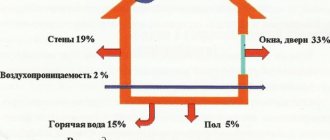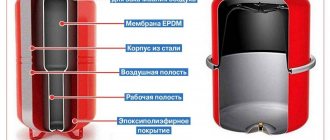Author of the article
Yulia Kuprina
Certified lawyer. Total work experience in the specialty is 13 years.
You can pay for thermal energy in different ways. The size of the fee depends not only on the number of batteries and the area of the apartment, but also on whether the apartment has heat meters. Let's figure out whether an individual heat meter is needed in an apartment building, where it is installed and how to take heat meter readings.
Why do you need a heating meter?
An individual metering device (hereinafter referred to as IMU) is necessary to take into account the amount of resource consumed in one apartment. Almost every apartment has meters for electricity, hot and cold water. This is the standard. But heat meters are not installed everywhere.
The current legislation does not contain rules obliging residents in apartment buildings to install IPU for heating. This is primarily due to the peculiarities of building houses.
The utility company is obliged to install a common house metering device (hereinafter referred to as UDPU), which takes into account the amount of thermal energy consumed in the entire house. But this rule does not apply to some older houses. Read a detailed article about installing a communal heat meter in an apartment building.
We list some features of installing the IPU on a battery:
- Purchase, installation, as well as periodic repairs and verification are entirely at the expense of the apartment owner.
- The technical possibility of installing IPU on batteries does not exist in every apartment. For example, in old houses, in which the heating system has horizontal wiring, you will have to install the device on almost every pipe in the apartment. This is difficult, costly, and most often not economically feasible. And the utility company is unlikely to coordinate the receipt of information about the amount of resource consumed from different metering devices.
- Not all resource supply companies are ready to accept and maintain heating accounting according to IPU. This is especially true for older houses. Before installing meters on the battery, this issue must be agreed upon with the resource supplier.
Standard heating consumption per sq. m.
Be that as it may, heating standards are not observed, so consumers have every right to file a corresponding complaint and demand a recalculation of tariff plans. The choice of one or another calculation method depends on whether a heat meter is installed in the house or apartment. In the absence of a general house meter, tariffs are calculated according to standards, and those, as we have already found out, are determined by local authorities. This is done through a special decree, which also determines the payment schedule - whether you will pay all year round or exclusively during the heating season.
The calculation methods and examples presented below provide an explanation of the calculation of the heating fee for residential premises (apartments) located in apartment buildings with centralized systems for supplying thermal energy.
How to take readings from the heat IPU
Before taking readings from the heat meter, read the instructions for the device. Readings are taken differently in different models. Usually, to do this you need to dial a combination (sequence) of buttons. Readings from the heat meter are taken by reading data from the monitor. But in addition to the necessary data, the display can contain information about the power and the temperature of the supplied heat. This information is not taken into account when calculating the heating fee.
Typically, a heat meter shows consumption in a similar way to water meters. We need numbers to the decimal point. There is no need to write numbers after the decimal point.
The unit of measurement is gigacalories (Gcal); it is in these units that heat consumption for payment is measured.
Every month on the same date, agreed upon with the resource supply company, you need to look at the numbers on the meter and report them.
Usually the fee is calculated based on the difference in the readings taken, that is, how much was consumed - what was paid for. But not in the case of calculating heating fees. Here, when calculating the fee, complex formulas will be used that take into account several indicators at once.
Standard gcal per square meter in 2021 Moscow region
The legal topic is very complex, but in this article we will try to answer the question “The norm of gcal per square meter in 2020, Moscow region.” Of course, if you still have questions, you can consult with lawyers online for free directly on the website.
In Tyumen, since the middle of the year, a single supplier of heating services for apartment buildings for the population (UTSK) was selected, and the tariff was 1,610.68 rubles. In Yaroslavl, the increase in prices for utilities also did not exceed 4%, the tariff increased from 1,551 rubles. up to 1615 rub. In the Krasnodar Territory, the tariff increased from 1993.61 rubles/Gcal to 2038.12 rubles/Gcal.
Thermal Energy Consumption Standard for Heating Gcal Sq M 2020
Organizational expenses spent on energy resources not used for heating citizens' homes. The calculation is carried out taking into account the difference in heat supply provided to tenants and the total amount of resource used. Thus, the more spacious the space occupied, the greater the amount for household expenses.
Basic standards for thermal energy consumption for heating
In September 2012, the Government signed a decree introducing into force a social norm for the use of public services. But at that moment it affected only certain types of services (electricity), but only certain areas. You need to find out whether there is a social norm in a particular area, as well as when it was approved, from regional sources.
Order of the Committee on Prices and Tariffs M.O. from 20.12.
2020 No. 392-r “On setting prices for natural gas sold to the population, as well as housing maintenance organizations, organizations managing apartment buildings, housing construction cooperatives and homeowners’ associations for the household needs of the population (except for gas for tenants of non-residential premises in residential houses)".
Heating fees account for approximately a quarter of the total utility bill. The tariff, the cost of one unit of energy (gigacalorie per square meter) spent on heating a room, increases annually. Accordingly, the amount of utility costs in each individual family or organization increases.
Many people are interested in the question of what tariff changes should be expected in the near future. Payment according to the standard for heating is made if a common house heat meter is not installed in the house. Payment for electricity, water supply, sewerage and gas is made according to established standards if an individual meter is not installed.
At the same time, it is also necessary to take into account the fact that according to the Decree of the Government of the Russian Federation of April 16, 2013 No. 344, if consumers do not have metering devices (collective or individual), if it is technically possible to install them, the standards for the consumption of utility services in residential premises will be applied increasing coefficients.
Standards for the consumption of utility services were created specifically to ensure that there is an economic justification for the tariffs at which citizens pay for housing and communal services.
Standard gigacalories per square meter in the Moscow region 2020
The standard may vary depending on how many people are registered in the apartment, the number of storeys of the building and its municipal category. From time to time, local authorities revise established standards, so payments in the past and current months may differ significantly.
: Okvad code for clothing trade 2020
How are general house standards determined?
Rules for establishing and determining standards for the consumption of utility services, approved by the RF Government of May 23.
2006 N306 (hereinafter referred to as Rules 306), in order to calculate the standard consumption of utility heating services, first provides for calculating the amount of thermal energy required for heating an apartment building or residential building during the year (clause 19 of Appendix 1 to Rules 306, formula 19).
- 6.9 cubic meters for cold water supply. If one person lives in an apartment, this is the basic norm for centralized water supply.
- It has been experimentally determined that less hot water is consumed. Therefore, the standard is set at 4.7 cubic meters. At the same time, the cost of hot water is higher, because heating requires additional resources;
- The standard for water disposal is calculated by summing the standards for hot and cold water. Again, the calculation method is used only for those high-rise buildings that have a centralized sewerage system.
Any other expenses cannot be included. Standards for general household needs can be calculated using two methods. The key feature here is whether a common meter is installed in the multi-storey building.
If it is available, the standard for ODN is calculated according to the formula of the readings of individual metering devices for residents minus the readings of a common house meter. Then the resulting value is simply divided by the number of people living in the house, taking into account the area of each apartment.
If there is no communal meter, the standard established in the region should be multiplied by the total area.
Social norms on water use
On average in Russia, citizens pay from 0.6 to 7 kW/h for one standard of consumed electricity. Results in different cities and regions always vary significantly. At the same time, residents themselves can influence the reduction of the final payment amount.
4. Establish the size of the standard cost of housing and communal services per family member per month for families of different sizes and a citizen living alone, differentiated by municipalities of the Moscow region, in a residential building of an individual housing stock for owners of residential premises for 2021 in accordance with Appendix 4 to this resolution.
6. The Main Directorate for Information Policy of the Moscow Region shall ensure the official publication of this resolution in the newspaper “Daily News.
Moscow Region", "Information Bulletin of the Government of the Moscow Region", placement (publication) on the website of the Government of the Moscow Region in the Internet portal of the Government of the Moscow Region and on the "Official Internet portal of legal information" (www.pravo.gov.ru).
Appendix 1. Dimensions of the standard cost of housing and communal services in the Moscow region per 1 sq. meter of total housing area per month in an apartment building for owners of residential premises for 2020 and for the planning period 2020-2020
5.
Establish the size of the standard cost of housing and communal services per family member per month for families of different sizes and citizens living alone, differentiated by municipalities of the Moscow region, for users of residential premises of state and municipal housing funds, tenants under rental agreements for residential premises of private housing funds and members of housing cooperatives for 2021 in accordance with Appendix 5 to this resolution.
The formulas have been changed for all cases, but special attention should be paid to the following situations: - The apartment building is equipped with a general building heat metering device and at least one, but not all premises are equipped with individual metering devices (previously, the calculation for this case was identical for the case of the presence of a control unit and the absence of an electrical control unit) ; — in the apartment building there are premises in which
How many Gcal is needed for heating 1 sq. m standard 2020
For those who will continue to be charged according to the standard, we will remind you how to request adjustments in heating fees.
WHY WE DECIDED TO REVISE THE FORMULAS FOR CALCULATION FOR HEATING In July 2020, the Constitutional Court of Russia ruled in favor of a resident of an apartment building from the city of Pushkino, who challenged the payment for heating according to the standard, since an individual meter was installed in his apartment.
Formula for calculating Gcal for heating
In addition to the main supplier of thermal energy, which holds almost the entire market in its hands, other companies have appeared that commission and service local boiler houses.
For most Moscow apartments, the tariff for houses connected to the heating network not directly, but through heating points, is taken into account. At the beginning of 2021, the tariff was 2199.24 rubles, after the tariff increase, the fee per unit of heat was already 2279.95 rubles. An important point.
The above methodology is valid on the territory of the Russian Federation and is valid for buildings where it is impossible to install building-wide heat meters for technical reasons.
According to paragraph 3, it is not clear what the amount Vi, which is subtracted from Vd, consists of. I received a receipt in which, according to this formula, I pay 3 times more for non-residential premises than for an apartment. In our house, approximately 10% have heat insulation units installed. Compared to December 2021, I paid 3 times more for heating alone. The Criminal Code cannot explain. According to their calculations, nothing is clear at all.
Tatyana, an amount that is incomprehensible to everyone is the so-called expenses for General Household Needs, heating of entrances, in other words. And this amount for all IPU owners, even if the house is not 100% equipped, is simply off the charts.
And now these smart guys who came up with these formulas are conducting paid seminars where they will assure everyone that everything is fine, everything is as it should be, it’s us who are illiterate. I see two options to fix everything. 1. Make calculations CORRECTLY, but definitely not using these formulas. 2. If they insist on these formulas, please. But there are standards for the consumption of ODN.
Anything in excess of the norm must be paid by the management company. This indicator is included in the receipt for those who do not use a personal meter, which helps control readings. Data is calculated based on costs in previous seasons. The amount of heat energy expended is divided by the number of heated square meters and divided into twelve months.
Thus, a value is obtained indicating how much you need to pay per square meter of living space. This figure is multiplied by the area of the premises and the regional special tariff.
Gas tariffs from January 1, 2021 for the population
Moreover, the calculation uses special formulas and many variables - technical characteristics of the house, type and degree of wear of engineering systems, and others. General building “meters” are a measurement tool that helps determine the amount of resources supplied to a specific apartment building.
When, at the beginning of the heating season, residents begin to receive payments for heating, many people think about how much heat costs, why it is so expensive, and how heating for an apartment is generally calculated.
Heating How Many Gcal Per Square Meter in 2021
It is the heated air from rooms equipped with heating radiators, penetrating through leaks in doors, walls, through ventilation ducts, through doorways when doors are opened, that helps maintain a higher temperature in the entrance than outside.
Standards for heat consumption in an apartment
The volume of thermal energy for heating 1 m2 of living space is determined based on the readings of a common house heat energy meter, or in the absence of a common house meter, based on the established standard.
The procedure for establishing the fact of non-provision of utility services is established by Section X of the Rules for the provision of utility services to owners and users of premises in apartment buildings and residential buildings (hereinafter referred to as the Rules), approved by Decree of the Government of the Russian Federation No. 354 of 05/06/2011.
Heating tariffs in the Moscow region in 2021
The book is the first to discuss topical issues related to the draft resolution of the Government of the Russian Federation “On the approval of standards and rules for the management of apartment buildings.”
With all amendments and changes that may be made to the project, its conceptual basis will remain unchanged.
Management standards for apartment buildings are normative documents that regulate management decisions and the responsibilities of officials.
Source: https://baiksp.ru/registratsiya-avtomobilya/norma-gkal-na-kvadratnyj-metr-v-2019-godu-moskovskaya-oblast
Laws on heat meters
List of regulations governing payment for heating by meter in an apartment building from 2021:
- The Housing Code of the Russian Federation, which sets out the initial provisions for the maintenance and payment of housing and communal services.
- Federal Law No. 190-FZ dated July 27, 2010, regulating the procedure for the production and transfer of heat, as well as all other relations arising in this area.
- Rules..., approved. RF PP dated 05/06/2011 No. 354 with amendments that came into force in 2021. They detail the procedure for calculating payments for heat, the quality of the supplied energy resource, as well as the procedure for installing heating meters.
- RF PP dated July 29, 2013 No. 642, which contains the rules for hot water supply.
- RF PP dated July 29, 2013 No. 644, which contains the Rules for cold water supply and sanitation.
- RF PP dated November 18, 2013 No. 1034, which contains the basic requirements for heat metering units.
- Other acts in the field of water supply, as well as GOSTs and SNiPs.
Heat standard per 1 sq m
If you want, let's try to roughly (roughly) estimate the main figures: Qmax = Qsp*Sq = 74*74 = 5476 kcal/h where Qsp = 74 kcal/h is the standardized specific heat energy consumption for heating 1 sq. m of apartment building. The value of Qd is taken according to Table 1 for buildings built before 1999, with a height (number of floors) of 5-9 floors at an outside air temperature of Tnro = -32 C (for the city K).
So if you have a corner room, then you need to add about twenty percent more to the resulting power value. The same amount should be added if your heating system is intermittent or has other efficiency deficiencies. Calculation of the power of heating radiators can be carried out in three ways: According to building codes and other rules, it is necessary to expend 100 W of the power of your radiator per 1 square meter of living space.
How to pay: options and formulas
Payment for heating, as well as the procedure for calculating it, depends on the following conditions:
- if there is no ODPU;
- if ODPU is installed;
- if it costs IPU heat.
Let's consider each case separately.
There is no ODPU heat in the house
If there is no ODPU heat in the house, you need to calculate the heating according to the standard, but depending on the following indicators:
- A tariff that is determined by a regulatory act of the tariff authority of a constituent entity of the Russian Federation. In other words, each region has its own tariffs.
- Area of the apartment (living space). Balconies and loggias are not included in this parameter.
- Established consumption standards in Gcal, which are determined by regulations. In each region, authorities independently determine this figure. It depends on climatic conditions.
The heat payment will be calculated using the formula:
P = N * T * P, where
P – payment;
N – standard established in the region;
T – tariff;
P – housing area.
As a result, the calculation does not depend on the actual amount of Gcal consumed. To increase the efficiency of heat supply, regulations have been adopted that determine the need to install metering devices.
ODPU is worth it, IPU is not
If the house is equipped with a common house heat meter, the calculation of the fee depends on the following indicators:
- The tariff, which is determined by the normative act of the tariff authority of the constituent entity of the Russian Federation.
- Heat consumption (calculated as the difference in readings taken from the meter).
- The area of the living space and the area of all other rooms in the house.
- Volumes of thermal energy.
In this case, the calculation formula will be much more complicated and for its final preparation it will initially be necessary to calculate the volume of thermal energy that is necessary for the residential premises in respect of which the calculation is being made (hereinafter referred to as indicator V):
V = S * ((V en / S rev – S ind + S oi)), where
S – area of housing (apartment);
S about – the sum of the areas of all rooms in this house;
S oi – the sum of the areas included in the common use property;
S ind is the total area of all rooms in which there are no heating devices or where there are other heating sources.
The formula for calculating the thermal energy fee will be as follows:
P = (V + (S * (V d – V) / Sob) * T, where
P – payment;
V – the volume of thermal energy that is necessary for the residential premises in respect of which the calculation is being made;
S – housing area;
V d – volume of thermal energy, calculated based on the readings of TDPU;
T – tariff.
There is a heat meter in both the house and apartment
If you have an apartment heat meter (IPU), and the house also has an ODPU, the calculation of heating fees will depend on the readings of the IPU heating meters.
The formula will consist of the following indicators:
P = ((V + V one * (S / S rev)) * T, where
P – payment;
V is the volume of thermal energy according to the readings of the IPU. The difference between the readings of the current month and the previous one is calculated;
V one - the volume of heat that entered the apartment building in public places (staircases, openings, basements, attics, etc.);
S – housing area;
S about – the total area of all premises of an apartment building;
T – tariff.
In this case, it is necessary to calculate V one using the formula:
V one = V d – V, where
V one - the volume of heat that entered the house in common areas (staircases, openings, basements, attics, etc.);
V d – volume of heat, calculated as the difference in the monthly readings of TDPU;
V is the volume of thermal energy calculated based on the readings of the IPU.
It is important that even if according to the IPU the amount of Gcal consumed is 0, you will still have to pay some amount for heating. This will be a payment for general house heat costs - for heating corridors and staircases.
How have consumption standards for utilities changed for the population in 2021
- P - amount of payment;
- K is the amount of thermal energy used for the entire heating period in dwellings where there are no PU;
- Stotal - the total area of all rooms in the house;
- P is the period of the heating period, calculated in months.
If there are none, fees are charged based on established standards. The cost of housing and communal services in the absence of meters is the sum of established standards depending on the number of people living in the apartment, which is multiplied by the tariff for a certain type of housing and communal services.
Calculation formula
Thermal energy consumption standards
Thermal loads are calculated taking into account the power of the heating unit and the heat losses of the building. Therefore, in order to determine the power of the designed boiler, it is necessary to multiply the heat loss of the building by an increasing factor of 1.2. This is a kind of reserve equal to 20%.
Why is such a coefficient necessary? With it you can:
- Predict the drop in gas pressure in the pipeline. After all, in winter there are more consumers, and everyone tries to take more fuel than others.
- Vary the temperature inside the house.
Let us add that heat losses cannot be distributed evenly throughout the entire building structure. The difference in indicators can be quite large. Here are some examples:
- Up to 40% of the heat leaves the building through the external walls.
- Through floors - up to 10%.
- The same applies to the roof.
- Through the ventilation system - up to 20%.
- Through doors and windows - 10%.
So, we sorted out the design of the building and made one very important conclusion: the heat losses that need to be compensated depend on the architecture of the house itself and its location. But much is also determined by the materials of the walls, roof and floor, as well as the presence or absence of thermal insulation. This is an important factor.
For example, let’s determine the coefficients that reduce heat loss, depending on window structures:
- Ordinary wooden windows with ordinary glass. To calculate thermal energy in this case, a coefficient of 1.27 is used. That is, through this type of glazing there is a leakage of thermal energy equal to 27% of the total.
- If plastic windows with double-glazed windows are installed, then a coefficient of 1.0 is used.
- If plastic windows are installed from a six-chamber profile and with a three-chamber double-glazed window, then a coefficient of 0.85 is taken.
Let's move on, dealing with the windows. There is a certain relationship between the area of the room and the area of window glazing. The larger the second position, the higher the heat loss of the building. And there is a certain relationship here:
- If the window area in relation to the floor area has only a 10% indicator, then a coefficient of 0.8 is used to calculate the thermal power of the heating system.
- If the ratio is in the range of 10-19%, then a coefficient of 0.9 is applied.
- At 20% - 1.0.
- At 30% -2.
- At 40% - 1.4.
- At 50% - 1.5.










